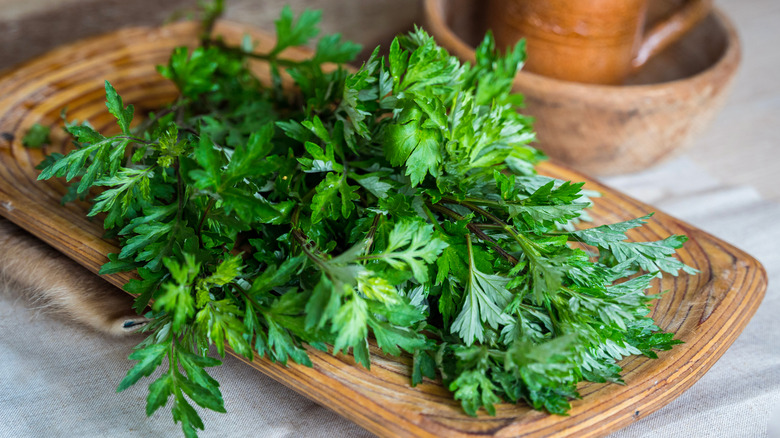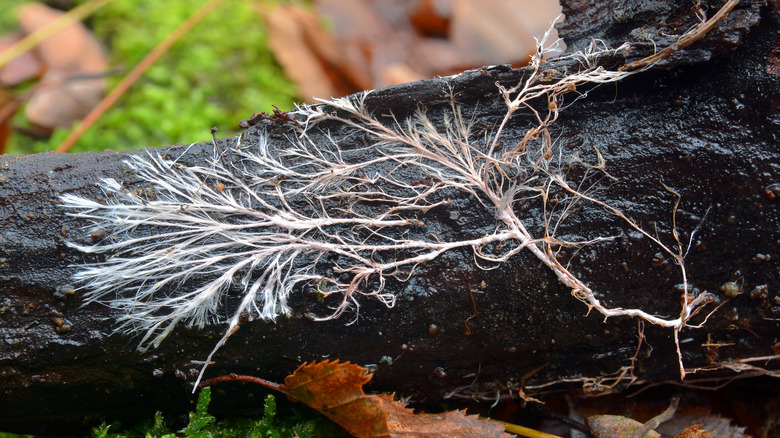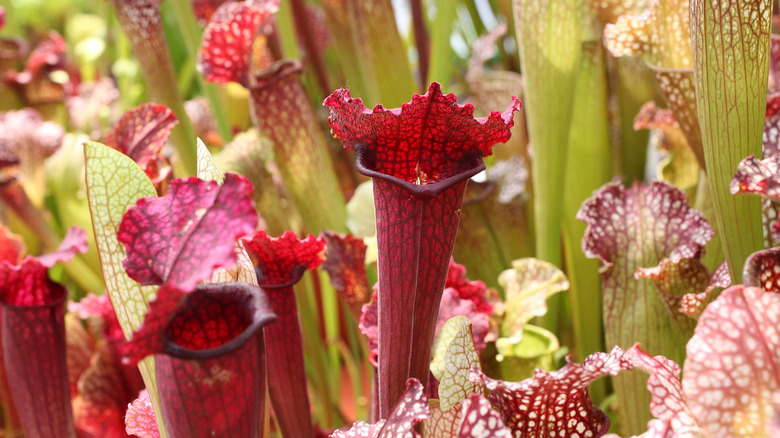The Unusual Way Plants Communicate With Each Other
We may receive a commission on purchases made from links.
Beginning in the 1970s with the release of the book-turned-documentary "The Secret Life of Plants," people have begun to dig into the science behind plant intelligence. Although many facts in the film were later debunked, it seems to have inspired a host of research into plants as sentient beings, including German forester Peter Wohlleben's book "The Hidden Life of Trees: What They Feel, How They Communicate" (via WIRED).
For example, some plants use listening skills to find water, while others can "taste" when an insect like a caterpillar is eating its leaves and send out repellent chemicals to warn them not to, according to Smithsonian Magazine. Although researchers interested in pursuing this field had to get over the initial challenges of skepticism resulting from outlandish claims that people could "speak" to plants using words like "Oryngham," which means thank you in plant, more and more research shows plants communicate with each other in many different ways (via The Independent).
The sagebrush speaks
In 1990, a pair of researchers, Clarence Ryan and Ted Farmer (who has the perfect name for studying plants), set out to discover why sagebrush plants were expelling large quantities of the chemical methyl jasmonate. They hypothesized it was a tool the plants were using to defend themselves against bugs, per WIRED. In their experiment, the researchers put leaves from the sagebrush plants into jars with tomato plants to see if neighboring plants would also trigger the release of the chemical, per WIRED. What they found was that when the sagebrush plants were in the jar with the tomato plant, the latter also started producing chemicals to ward off insects.
That led them to conclude in their 1990 paper in PNAS that "interplant communication can occur." In other words, the sagebrush had a secret to tell the tomato plant, transmitted in some sort of unspoken form of communication.
The language is universal
Although some people, still triggered by the falsehoods of "The Secret Life of Plants," were skeptical of this research for a long time, more and more studies started to support the idea that plants could communicate with each other. A similar study conducted in the wild, for example, also found that tobacco plants started releasing a chemical to ward off insects when researchers clipped the sagebrush's leaves like the teeth of a caterpillar would, per WIRED. That suggested, although didn't yet prove, that the sagebrush's methyl jasmonate worked as a signal, somehow communicating to neighboring plants that the insects were coming. And over time, it worked: The plants that "listened" to the sagebrush's signal were in better shape, with fewer bites from critters.
These combinations with sagebrush weren't the only experiments conducted at this time. Lima beans, corn seedlings, chili peppers, and cucumbers were all found to send and receive signals that allowed them to protect themselves against predators.
Back to the roots
While the release of chemicals to communicate in this manner is a form of airborne communication, plants also use an internet of fungus to communicate underground. According to Inverse, this complex network called the mycorrhizae helps plants absorb and find nutrients in exchange for the nutrients the plant is absorbing and converting for food from sunlight. Through this web, plants can also communicate warnings about potential threats, giving their neighbors time to prepare themselves against predators. When a certain plant has an excess of nutrients, it can use this web to share the extra food with neighboring plants.
Interestingly, although plants can thrive in this "community," they also know when to take some time alone. That is, if a plant doesn't have enough nutrients to share with the network, it can break itself off from the underground web. Long before humans were "social distancing" in the pandemic to protect themselves, the plants seemed to be doing it too.
Recognizing kin
Using the knowledge that plants were interconnected through this system, scientists conducted a study in Biology Letters in 2008 to determine if plants liked some of its neighbors better than others. Humans and other animals typically reside where they feel most comfortable, so why not plants? Typically, the plant used in the study — the Great Lakes sea rocket — protects its territory by shooting out roots in every direction that eat up all of the nutrients available in the soil, preventing other plants from growing near it, according to The New York Times.
However, what the researchers found was that when the sea rocket had other sea rocket plants neighboring it, the plants didn't send out their usual aggressive signals to ward off neighbors (via The New York Times). Instead, it seemed to welcome its kin as its neighbor. Other plants have been shown to preferentially share more food with plants of the same genetic species, a phenomenon that happens in mammals and human beings as well, per Inverse.
Interspecies communication
In some studies, plants have been shown to be able to communicate with non-plants as well. According to Scientific American, some plants can "listen" for the buzzing sound of a bee's wings and produce more pollen when they fly nearby. In another study in Current Biology, scientists found some of the first evidence that plants could communicate with more than just plants and insects; they could also "speak" to mammals.
A certain kind of carnivorous pitcher plant native to Asia, already arguably mammalian with its eating habits, uses the concave structure of its mouth openings to reflect bats' echolocation and attract them, per Current Biology. The pitcher plants actually want to attract the bats because the bats don't pose a threat like some insects do, tearing away at the plant's leaves or stem. Instead, the bats shelter themselves in the plant's concave mouth, where they deposit guano, or bat poop, that helps provide nutrients to the plant, per Current Biology.
Together the evidence shows plants are far more intelligent than they have previously been credited for, although that intelligence may not stack up to the "wisdom," that those who claim their plants have given them "Yoda-like advice" claim plants have (via The Independent).





